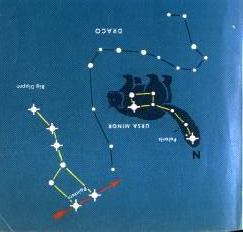|

|
Constellations
|

Constellations are names for groups of stars that
appear to form shapes in the sky. They were given their names many
hundreds of years ago to help us remember which stars are which. We
use constellations to divide up the sky; finding one can help us find
another because constellations move so slowly that, in our
lifetime, they will always be found in about the same place.

The Big Dipper (Ursa Major or the Great
Bear)
The best known group of stars is the Big Dipper;
you have probably heard of it or even seen it. The Big Dipper is a
group of seven bright stars, 3 which form a handle and 4 which form a
bowl. (The Big Dipper is yellow in the picture below). The Big Dipper is not actually a constellation but is part
of the constellation Ursa Major, or Great Bear.
 The Big Dipper in Ursa
Major
The Big Dipper in Ursa
Major
|
 The Little Dipper in Ursa
Minor
The Little Dipper in Ursa
Minor
|
 Little
Dipper (Ursa Minor or the Little Bear)
Little
Dipper (Ursa Minor or the Little Bear)
The Little Dipper is
a mirrored and smaller version of the Big Dipper. It can be found by
looking directly up from the two outermost stars which form the bowl
on the Big Dipper. These two stars point us to Polaris, the Pole Star
(indicating the North Pole), which is at the end of the Little
Dipper's handle. (See picture on right above).

Orion
Another well-known
constellation is Orion. Orion was an ancient Greek hunter and warrior
and the constellation resembles this figure, with a club and a
shield, and a sword dangling from his belt. The belt is usually the
easiest part of Orion to spot, with three bright stars in a row. Can
you find his belt in the picture below? Orion has more bright stars
than any other constellation; the two brightest are Betelguese
(shoulder) and Rigel (foot).


Cassiopeia
Casseopeia is found
next to the Big Dipper and Orion. Its shape is easy to remember, a
neat W, or M, formed by 5 bright stars. Casseopeia is the
mythological Queen of Ethiopia.


|
The
Pleiades (Seven Sisters)
|

|
The Seven Sisters
were said to be the daughters of Atlas and the objects of Orion's
affection. As the name Seven Sisters implies, there are seven stars
in this constellation but most people can only see six. The Pleiades
is located between the constellations of Taurus and Perseus.

Sky
Chart
|

|
This chart shows some of the
constellations I have mentioned. In the middle you can see
the Big Dipper, which can direct us to several other
constellations around it. As mentioned above, the side of
the Big Dipper's bowl points to Polaris in the Little
Dipper. The bottom of the bowl points to the constellation
Gemini, the left side of the bowl to the constellation, Leo,
and the handle to Bootes. Casseopeia can also be seen in
the top left corner. To find out more about any of the
constellations mentioned here (and those which aren't) visit
some of the sites listed below.
|

Links to
other constellation web sites
The
Constellations
Information
relating to the 88 mythical constellations.
The
Constellations and their Stars
Statistics,
history, and mythology for all 88 constellations and the named stars
in them.
Dome
of the Sky
An online
planetarium showing the positions of stars and constellations at
different dates throughout the year. Use this for finding the
relative locations of the constellations.
Galaxy
Guide
Check out the
constellation of the month.
